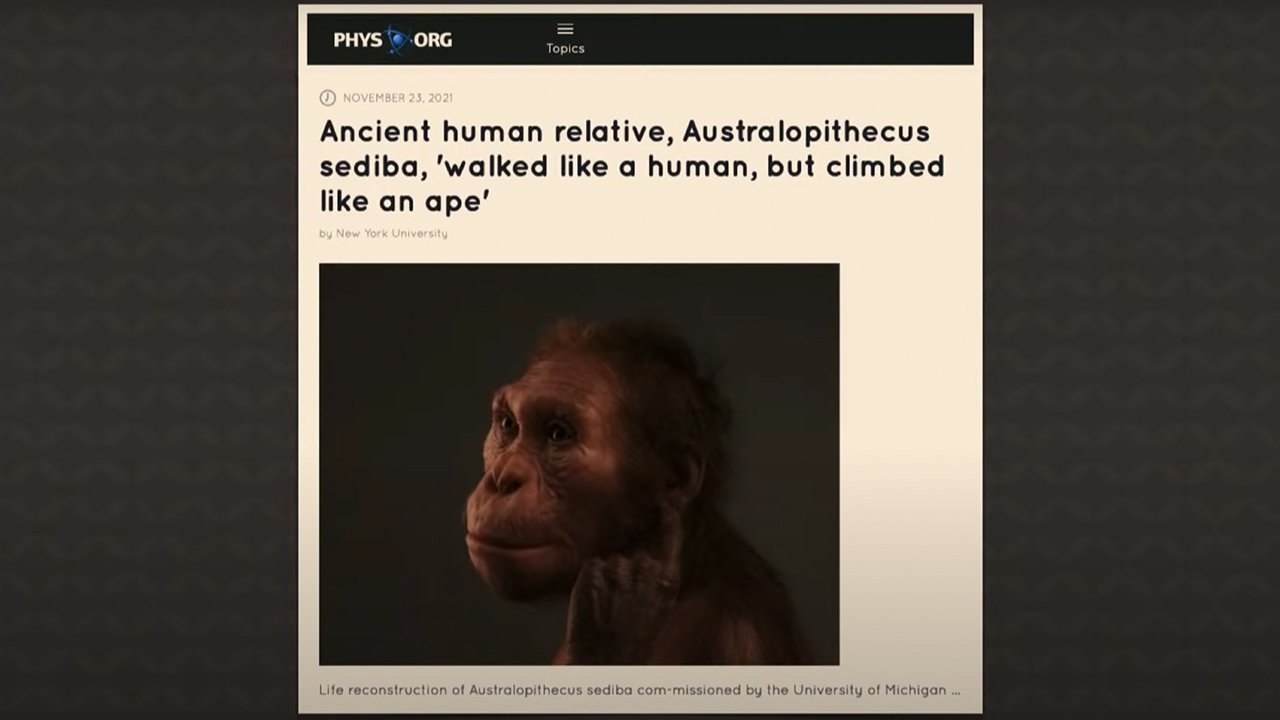
Did a “Human Ancestor” Walk like Us but Climb like Apes?
Paleontologist Dr. Gabriela Haynes reviews a recent study on Australopithecus sediba and debunks the claim that it's a “missing link" between apes and humans.
Australopithecus sediba—did it walk like a human but climb like an ape? According to a recent study, new lower back fossils of this so-called “human ancestor” supposedly “settles a decades old debate proving early hominins used their upper limbs to climb like apes and their lower limbs to walk like humans.” Now, we’ve said for years that A. sediba was just an ape. But does this new study show it was indeed a “missing link,” as the article claims?
Paleontologist Dr. Gabriela Haynes, one of the members of our research team, shares this about A. sebiba and the new study:
The new paper argues that Issa, the name given to the skeleton of this Australopithecus sediba specimen, walked somewhat like a human. However, just because it supposedly could have walked like a human does not make it a human or human ancestor. But because of the researchers’ evolutionary worldview, any slight resemblance, or sign of resemblance, leads them to conclude that man and ape shared a common ancestor.
Bipedalism is thought to have evolved gradually. Since evolutionists have the idea of things evolving over time, they need to find a transition process to fit in this story. But despite their hope, many details of this fossil find bring challenges to their evolutionary assumptions to the table.
The data points to A. sediba being an ape, but their forced interpretation on the feet and legs means that upright walking evolved in different ways during human evolution because they point to a very odd way of walking. An explanation for why walking evolved that way is a challenge for them.
Here are a few things to consider regarding this claim:
The pelvis of this genus, Australophitecus, was modified by a scientist in his lab, taking the shape of a humanlike hip, despite being an apelike hip.
The bones of the hand are very similar to those of orangutans, and dental analysis from Malapa Hominin 1 (MH1), an A. sediba specimen, shows similarities to chimpanzees.
The valgus angle (the angle at which the femur and the tibia meet at the knee) is not good evidence for bipedal locomotion since both orangutans and spider monkeys have the same valgus angle within the range of humans. That is a feature related to the way they walk on tree branches. As the study authors state: “However, other aspects of the bones’ shape suggest that as well as walking, A. sediba probably spent a significant amount of time climbing in tree.”
The fossil material—skull, cranial capacity, body proportions, teeth, and thorax (narrow upper chest)—for this species, Australopithecus sediba, is very apelike, and they all resemble other australopithecines (apes).
The inward curve of the lumbar spine was shown as one of the evidences that this animal could have walked upright, since this feature is typically used to demonstrate adaptations to bipedalism. However, the lumbar lordosis was based on a reconstruction of the pelvis. One prediction based on the lumbar vertebrae produced a strong lumbar lordosis (hyperlordosis). Another reconstruction done produced a less lordotic lumbar (hypolordotic), and a new reconstruction showed a humanlike one. “Therefore, current interpretations of lumbar curvature of A. sediba range from hyperlordotic to hypolordotic.” In other words, anything can fit in this parameter which shows there is a problem.
The new finds “suggest that MH2 (Australopithecus sediba specimen) was probably neither hypolordotic nor hyperlordotic and produces a combined wedging angles value more similar to modern humans than great apes.”
So, the data is hardly conclusive that this creature walked upright—let alone that it’s some kind of human ancestor! From a biblical worldview, we understand that creatures were created according to their kinds, so A. sediba isn’t some kind of missing link between apelike creatures and humans. Like other australopithecines, A. sediba is just an example of variety within the ape kind, and it likely spent much of its time climbing or walking around in trees, like apes do today. It’s only the evolutionists’ interpretations, based on their worldview, that creates an upright walking ancestor to man. They are so desperate to find a supposed missing link!
Get More Answers on Answers News
I discussed this item yesterday on Answers News with cohosts Patricia Engler and Dr. Georgia Purdom. Answers News is our twice-weekly news program filmed live before a studio audience and broadcast on my Facebook page and the Answers in Genesis Facebook page. We also covered the following topics:
- More American adults say they aren’t having children.
- Thanksgiving . . . time to celebrate creation?
- Did human canine teeth shrink millions of years ago?
- And more!
Be sure to join us each Monday and Wednesday at 2 p.m. (ET) on my Facebook page or the Answers in Genesis Facebook page for Answers News. You won’t want to miss this unique news program that gives science and culture news from a distinctly biblical and Christian perspective.
Thanks for stopping by and thanks for praying,
Ken
This item was written with the assistance of AiG’s research team.
Most Recent News
-
Dec. 23, 2025 from Ken Ham Blog
A recent news item caught my eye when I saw the headline: “18,000 dinosaur tracks discovered along ancient Bolivian coastline.”
-
Dec. 22, 2025 from Ken Ham Blog
“Why should God have anything against there being four of them rather than two?” is the question a clergywoman in Germany asked recently.

Answers in Genesis is an apologetics ministry, dedicated to helping Christians defend their faith and proclaim the good news of Jesus Christ.
- Customer Service 800.778.3390
- Available Monday–Friday | 9 AM–5 PM ET
- © 2025 Answers in Genesis



